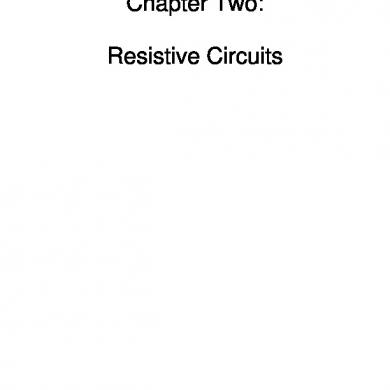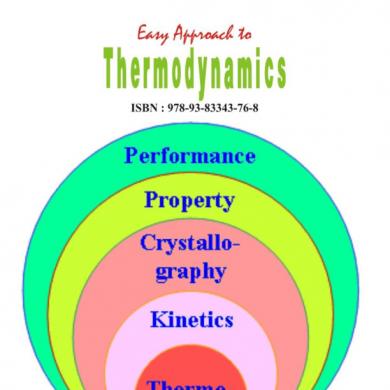Thermodynamics - Chapter 2
This document was uploaded by user and they confirmed that they have the permission to share it. If you are author or own the copyright of this book, please report to us by using this DMCA report form. Report DMCA
Overview
Download & View Thermodynamics - Chapter 2 as PDF for free.
More details
- Words: 605
- Pages: 11
Loading documents preview...
TOPIC 2 First Law of Thermodynamics and it Processes First law of thermodynamics Forms of energy transfer (slide 1, slide 2) Forms of work Closed system Non flow process (slide 1, slide 2) Open system Flow process Flow process application
First Law of Thermodynamics • First Law refers to conservation of energy
• Or easily stated as, energy cannot be created or destroyed, it can only change or transferred
Forms of energy transfer • Heat, Q : energy transferred across boundary due to temperature differences between system and its surrounding Q +ve if heat energy flows into the system from the surroundings. Q –ve if heat energy flows from the system to the surroundings
• Work, W : energy transferred across boundary by a flow, but not caused by temperature differences W +ve if work energy is transferred from the
Surrounding
Forms of energy transfer (cont.) • Internal energy, U : the sum of all the energies a fluid possesses and stores within itself. The molecules of a fluid may be imagined to be in motion thereby possessing kinetic energy of translation and rotation as well as the energy of vibration of the atoms within the molecules. In addition, the fluid also possesses internal potential energy due to intermolecular forces.
U2 U1, the internal energy has increased. U1 U2, the internal energy has decreased.
Forms of work
• Expansion or compression work • Shaft work • Electrical work • Flow work • Viscous work
Closed System
• A close system (also known as a control mass) consists of a fixed amount of mass, and no mass can cross its boundary. • That is, no mass can enter or leave a close system • But energy, in the form of heat or work can cross the boundary, and the volume of a close system does not have to be
Non–flow Process In a close system, although energy may be transferred across the boundary in the form of work energy and heat energy, the working fluid itself never crosses the boundary. Any process undergone by a close system is referred to as the non-flow process. If the fluid is undergoing a non-flow process from state (1) to state (2) then the terms from the general equation for p1V1 and p2V2 (which represent the amount of work energy required to introduce and expel the fluid from the system) will be zero, since the fluid is already in the system, and will still be in the system at the end of the process.
U2 – U1 = Q –W
Non flow energy equation
Non-flow Processes
• Constant temperature (Isothermal) process (pV = C) • Adiabatic process (Q = 0) • Polytropic process (pVn = C) • Constant volume process • Constant pressure process
Open System
• An open system, or a control volume, is a properly selected region in space. It usually encloses a device, which involves mass flow.
• Both mass and energy can cross the boundary of a
Flow Process In an open system, not only the energy transfers take place across the boundary, the fluid may also cross the boundary. Any process undergone by an open system is called a flow process. This process may be subdivided into an unsteady flow process and steady flow process.
C12 C 22 gZ1 u1 P1v1 Q gZ 2 u 2 P2 v2 W 2 2 Steady flow energy equation
Flow Process Application
• Boiler • Compressor • Turbine • Pump • Nozzle • Diffuser • Throttling valve • Heat exchanger
First Law of Thermodynamics • First Law refers to conservation of energy
• Or easily stated as, energy cannot be created or destroyed, it can only change or transferred
Forms of energy transfer • Heat, Q : energy transferred across boundary due to temperature differences between system and its surrounding Q +ve if heat energy flows into the system from the surroundings. Q –ve if heat energy flows from the system to the surroundings
• Work, W : energy transferred across boundary by a flow, but not caused by temperature differences W +ve if work energy is transferred from the
Surrounding
Forms of energy transfer (cont.) • Internal energy, U : the sum of all the energies a fluid possesses and stores within itself. The molecules of a fluid may be imagined to be in motion thereby possessing kinetic energy of translation and rotation as well as the energy of vibration of the atoms within the molecules. In addition, the fluid also possesses internal potential energy due to intermolecular forces.
U2 U1, the internal energy has increased. U1 U2, the internal energy has decreased.
Forms of work
• Expansion or compression work • Shaft work • Electrical work • Flow work • Viscous work
Closed System
• A close system (also known as a control mass) consists of a fixed amount of mass, and no mass can cross its boundary. • That is, no mass can enter or leave a close system • But energy, in the form of heat or work can cross the boundary, and the volume of a close system does not have to be
Non–flow Process In a close system, although energy may be transferred across the boundary in the form of work energy and heat energy, the working fluid itself never crosses the boundary. Any process undergone by a close system is referred to as the non-flow process. If the fluid is undergoing a non-flow process from state (1) to state (2) then the terms from the general equation for p1V1 and p2V2 (which represent the amount of work energy required to introduce and expel the fluid from the system) will be zero, since the fluid is already in the system, and will still be in the system at the end of the process.
U2 – U1 = Q –W
Non flow energy equation
Non-flow Processes
• Constant temperature (Isothermal) process (pV = C) • Adiabatic process (Q = 0) • Polytropic process (pVn = C) • Constant volume process • Constant pressure process
Open System
• An open system, or a control volume, is a properly selected region in space. It usually encloses a device, which involves mass flow.
• Both mass and energy can cross the boundary of a
Flow Process In an open system, not only the energy transfers take place across the boundary, the fluid may also cross the boundary. Any process undergone by an open system is called a flow process. This process may be subdivided into an unsteady flow process and steady flow process.
C12 C 22 gZ1 u1 P1v1 Q gZ 2 u 2 P2 v2 W 2 2 Steady flow energy equation
Flow Process Application
• Boiler • Compressor • Turbine • Pump • Nozzle • Diffuser • Throttling valve • Heat exchanger
Related Documents

Thermodynamics - Chapter 2
March 2021 0
Fuelless Generator Thermodynamics 2
January 2021 3
Thermodynamics
January 2021 1
Chapter 2
February 2021 1
Thermodynamics
January 2021 1
Chapter 2
March 2021 0More Documents from "Kalven Perry Agustin"

Thermodynamics - Chapter 2
March 2021 0